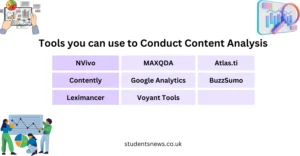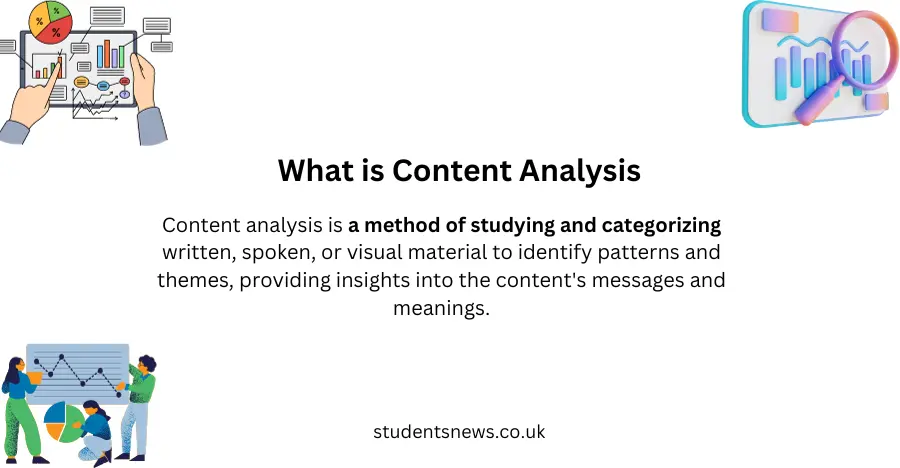Content analysis is a research technique used to systematically analyze the content of communication. This method is popular in various fields, including sociology, psychology, and media studies, as it helps researchers to quantify and analyze the presence, meanings, and relationships of certain words, themes, or concepts within the data. This article will delve into the advantages and disadvantages of content analysis, explore its methodology, and discuss its applications in different disciplines.
What is Content Analysis?
Content analysis involves systematically coding and interpreting texts, images, and other forms of media to identify patterns and meanings. Researchers use this method to understand the underlying messages, themes, and trends within the data.
Applications of Content Analysis
- Sociology: Analyzing social trends and communication patterns.
- Psychology: Understanding behavioral and cognitive responses in communication.
- Media Studies: Evaluating media content, bias, and representation.
The content analysis process typically involves the following steps:
- Defining Research Objectives: Outline research questions or objectives.
- Sampling: Select representative materials for analysis.
- Unit of Analysis: Determine specific elements to be analyzed.
- Coding: Develop a coding scheme to classify content.
- Training Coders: Train coders for consistent application.
- Coding Process: Analyze content using the coding scheme.
- Data Analysis: Identify patterns and relationships in coded data.
- Drawing Conclusions: Interpret findings and draw conclusions.
You can read a detailed article on doing content analysis with an example here.
Content analysis can be applied to various types of content, such as text documents, interviews, social media posts, advertisements, and more. It provides a systematic and structured approach to understanding the content and can be used to gain insights into cultural trends, communication patterns, public opinions, and other phenomena. Let’s say that you have collected qualitative data or you might have collected quantitative data, then you can use content analysis to analyze the data and formulate a hypothesis.
Let’s compare the advantages and disadvantages
| Aspects | Advantages | Disadvantages |
|---|---|---|
| Insight into Patterns and Trends | Provides a comprehensive understanding of patterns and trends. | Potential for variation in interpretation among coders. |
| Flexibility Across Various Content Types | Adaptable to different formats (text, visuals, audio, digital). | Focuses on content without a deep exploration of contextual factors. |
| Objective and Replicable Results | Emphasizes systematic and objective coding for reliability. | Simplifying complex information may lead to oversimplification. |
| Exploration of Unconscious or Implicit Elements | Uncovers implicit elements within communication material. | Difficulty in establishing cause-and-effect relationships. |
| Cost-Effective and Time-Efficient | More cost-effective and time-efficient compared to alternatives. | May struggle to keep up with the dynamic nature of rapidly changing content. |
This consolidated table presents the various aspects, along with both the advantages and disadvantages of content analysis, in a concise format.
Advantages of Content Analysis
Here is a list of some advantages that content analysis offers:
Rich Insight into Patterns and Trends

Content analysis provides researchers with a comprehensive understanding of patterns and trends within a dataset. By systematically examining the content, researchers can identify recurring themes, key messages, or prevalent sentiments.
For instance, analyzing a collection of online reviews for a product can reveal common customer opinions and sentiments, helping companies gain valuable insights into consumer preferences.
Advantages of Content Analysis
Unobtrusive Data Collection
Content analysis involves analyzing existing texts or media, which means that data collection does not interfere with the subjects. This makes it a non-intrusive method that respects the privacy and normal activities of individuals.
Flexibility and Versatility
This method can be applied to a wide range of data sources, including books, newspapers, speeches, social media posts, and videos. This flexibility allows researchers to adapt content analysis to various research questions and fields.
Quantitative and Qualitative Insights
Content analysis can be used to gather both quantitative (counting and measuring) and qualitative (interpreting and understanding) data. This dual approach enriches the research by providing a comprehensive view of the content being studied (publichealth.columbia).
Cost-Effective
Since content analysis often uses existing data, it is generally less expensive compared to other research methods that require data collection through surveys, experiments, or fieldwork. This makes it a budget-friendly option for researchers.
Historical and Cultural Insights
By analyzing historical documents and media, researchers can gain insights into past events and cultural trends. This retrospective analysis can help understand how communication has evolved over time and its impact on society.
Disadvantages of Content Analysis
Time-Consuming
Content analysis can be very time-consuming, especially when dealing with large volumes of data. The process of coding and analyzing the data manually can be labor-intensive and slow, which may not be feasible for researchers with limited time (Scribbr).
Potential for Bias
The subjective nature of interpreting content can introduce bias. Researchers may inadvertently let their own beliefs and expectations influence the coding process, leading to skewed results. Ensuring objectivity and consistency in coding is crucial to mitigate this issue.
Limited to Available Content
Content analysis is restricted to analyzing available texts and media. If relevant data is not accessible or does not exist, the research may be limited. Additionally, this method cannot capture real-time data or dynamic interactions.
Over-Simplification
Reducing complex communications to codes and categories can sometimes oversimplify the data, losing the nuance and context that are important for a deep understanding. This can be particularly problematic in qualitative research where context is crucial.
High Potential for Error
There is a higher potential for error, especially when conducting relational content analysis. Coding errors and misinterpretations can occur, affecting the reliability and validity of the research findings.
Applications in Different Fields
Sociology
In sociology, content analysis is used to study social trends, cultural norms, and communication patterns. For example, researchers might analyze newspaper articles to understand public opinion on social issues like immigration or healthcare (Mailman School).
Psychology
Psychologists use content analysis to explore cognitive and emotional responses in communication. For instance, analyzing therapy session transcripts can help identify common themes in patients’ narratives and understand their emotional states.
Media Studies
Media studies often employ content analysis to evaluate media content, bias, and representation. An example is analyzing television shows to study the portrayal of gender roles and stereotypes.
Conclusion
Content analysis is a powerful research method that offers valuable insights into communication patterns and meanings. Despite the limitations of content analysis, such as the potential for bias and time-consuming nature, its advantages make it a widely used technique in various fields. By carefully designing the study and ensuring objectivity in coding, researchers can effectively use content analysis to uncover important trends and relationships within their data.
FAQs
What is a weakness of content analysis?
One major weakness of content analysis is its potential for bias, as the interpretation of content can be influenced by the researcher’s own perspectives.
What are the advantages of content analysis in research?
The main advantages include its unobtrusive nature, flexibility, ability to provide both quantitative and qualitative insights, cost-effectiveness, and its usefulness in gaining historical and cultural insights.
How is content analysis conducted?
Content analysis involves defining research questions, selecting a sample, developing a coding scheme, coding the data, analyzing the results, and drawing conclusions based on the findings.


